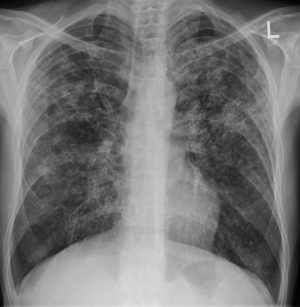Miliary tuberculosis
| Miliary tuberculosis | |
|---|---|
| Synonyms | disseminated tuberculosis, tuberculosis cutis acuta generalisata, tuberculosis cutis disseminata |
 |
|
| Chest X ray showing miliary tuberculosis | |
| Classification and external resources | |
| Specialty | infectious disease |
| ICD-10 | A19 |
| ICD-9-CM | 018 |
| MedlinePlus | 000624 |
| eMedicine | med/1476 |
| MeSH | D014391 |
Miliary tuberculosis is a form of tuberculosis that is characterized by a wide dissemination into the human body and by the tiny size of the lesions (1–5 mm). Its name comes from a distinctive pattern seen on a chest radiograph of many tiny spots distributed throughout the lung fields with the appearance similar to millet seeds—thus the term "miliary" tuberculosis. Miliary TB may infect any number of organs, including the lungs, liver, and spleen. Miliary tuberculosis is present in about 2% of all reported cases of tuberculosis and accounts for up to 20% of all extra-pulmonary tuberculosis cases.
Patients with miliary tuberculosis often experience non-specific signs, such as coughing and enlarged lymph nodes. Miliary tuberculosis can also present with enlarged liver (40% of cases), enlarged spleen (15%), inflammation of the pancreas (<5%), and multiple organ dysfunction with adrenal insufficiency (adrenal glands do not produce enough steroid hormones to regulate organ function). Miliary tuberculosis may also present with unilateral or bilateral pneumothorax rarely. Stool may also be diarrheal in nature and appearance.
Other symptoms include fever, hypercalcemia, chorodial tubercles and cutaneous lesions. Firstly, many patients can experience a fever lasting several weeks with daily spikes in morning temperatures.
Secondly, hypercalcemia prevails in 16 to 51% of tuberculosis cases. It is thought that hypercalcemia occurs as a response to increased macrophage activity in the body. Such that, 1,25 dihydroxycholecalciferol (also referred to as calcitriol) improves the ability of macrophages to kill bacteria; however, higher levels of calcitriol lead to higher calcium levels, and thus hypercalcemia in some cases. Thus, hypercalcemia proves to be an important symptom of miliary tuberculosis.
Thirdly, chorodial tubercules, pale lesions on the optic nerve, typically indicate miliary tuberculosis in children. These lesions may occur in one eye or both; the number of lesions varies between patients. Chorodial tubercules may serve as important symptoms of miliary tuberculosis, since their presence can often confirm suspected diagnosis.
Lastly, between 10 and 30% of adults, and 20–40% of children with miliary tuberculosis have tuberculosis meningitis. This relationship results from myobacteria from miliary tuberculosis spreading to the brain and the subarachnoid space; as a result, leading to tuberculosis meningitis.
...
Wikipedia
